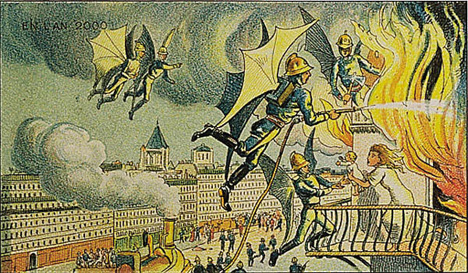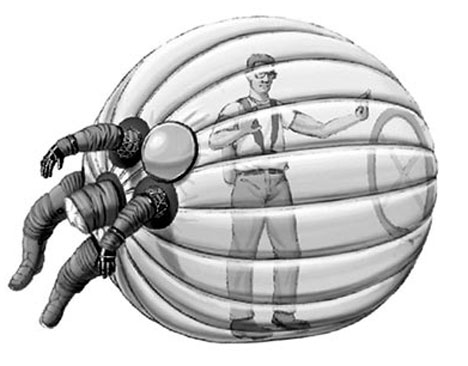 |
| Terrifying bat-winged firefighters from a 1910 French post card |
The future is so notoriously difficult to foresee that looking back on what was predicted by generations past more often than not looks absurd than clairvoyant. Science fiction authors and designers know this, yet plunge nevertheless into imagining the aesthetics of our future, with varying degrees of predictive success. But as time goes on, history tends to demolish even the tamest predictions, and one small technological development can render an entire potential future impossible - just look at what the internet has done to the clunky future-worlds of Alien or The Terminator.
But the point is never really prediction, is it? The goal is fantasy, using the current now as a launchpad from which to imagine what's to come (in fact that reliance on the now of the time of creation is so important that in general, science fiction says far more about that particular point in history than it ever could about the future).
With that in mind, I'm always fascinated by what changes are happening in science today, that will inspire another artist or writer to dream up some bizarre future for us to inhabit. One such change comes to us thanks to the privatization of space flight:
 |
| Reality, not a prediction |
The Biglow Expandable Activity Module (BEAM) is the creation of Robert Bigelow, billionaire hotelier and relentless pusher of the idea that space stations should not be made of metal, but of fabric. The advantages are many - the fabric can expand, allowing one to cheaply transport a collapsed version of the station for later expansion; the strong super-fibers are better protection against micro-meteors and space radiation; and the production cost is a fraction of building one from metal.
The difference between Bigelow and most billionaire's fanciful ideas is that this is actually going into space in 2015, and will actually be attached to the International Space Station currently orbiting us.
Thus my primary concern: since they're coming, and can't be stopped, how will space blimps affect science fiction?
We're so used to the parallels between starfighters and jet planes that we forget that the laws of aviation do not apply in a vacuum. There's no need for wings, an aerodynamic design, or weight considerations in outer space. A giant inflatable balloon might very well be the answer to all zero-gravity engineering problems. Being as the classic starfighter is already becoming a tired design, perhaps this is where the future is leading us: giant bulbous globes equipped with hideous space-saws to rip each other's fabric into pieces! Or spherical space-robots battling humanity's last hope: the interstellar military zeppelin S.S. Inflatable! Excited yet?
At the end of the day, I suppose my attempt to predict the future of future predictions is awfully redundant, and as futile as any prediction at all. I would enjoy it, however, if the far-future reboot of Star Wars depicts Luke wandering about the galaxy in a bladder-suit:
 |
| WTF |

No comments:
Post a Comment